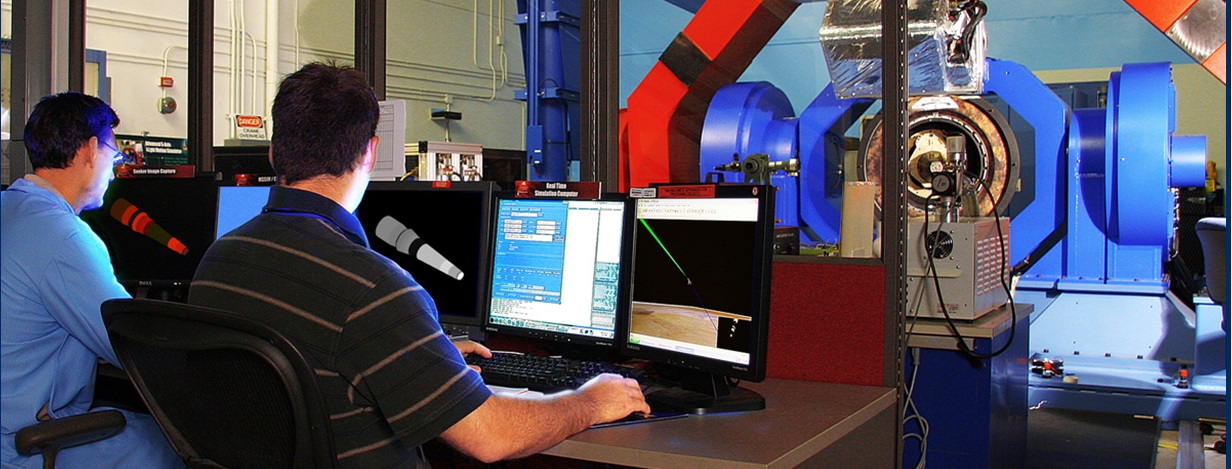
Georgia Tech Research Institute (GTRI) researchers are working with a local company and the U.S. Missile Defense Agency (MDA) to test high-altitude missiles without ever firing a shot.
AEgis Technologies, specialists in modeling and simulation, contracted GTRI’s Applied Systems Laboratory to collaborate with MDA on testing high-altitude air defense missiles. ASL is in its second phase of a multi-year project utilizing “hardware-in-the-loop” testing to enable more accurate modeling and simulation for its customer.
“Testing a missile can be very expensive,” said GTRI Senior Research Engineer and principal investigator Glenn Parker. “Additionally, because of the large number of control variables in a real exercise, it isn’t technically feasible to get complete testing coverage. High-fidelity simulation addresses many of these concerns, but even with modern processors it can take days to compute the trajectory and heat signature of a complex ballistic target.”
Hardware-in-the-loop simulations use portions of the real missile hardware, such as the seeker, with any missing pieces made up by simulated components.
“We use the missile’s actual guidance system and manipulate simulated inputs to make the hardware think it is flying,” Parker said. “By using real hardware in tests, confidence in the results is much higher than in fully simulated models. For non-reusable portions of the missile like the motor and warhead, the use of simulation models makes it possible to run thousands of test cycles without leaving the laboratory, and for less than the cost of one live test.”
With current testing models, thermal signature databases must be computed offline prior to the test, and can take up to three days for a mere fifteen minutes of simulation time. Any alteration to the parameters—altitude, weather, terrain, or even the position of the sun—requires a total re-coding of the database. Testing a missile launch from Hawaii, for example, to intercept a target at a certain distance, altitude and speed takes a long time to calculate all of the missile hardware inputs that are used in the test.
What GTRI is working on, according to Parker, will enable the simulated components to be “looped in” for real-time calculation, eliminating the need for database computation ahead of time. Using off-the-shelf NVIDIA graphics cards, the group will work to provide the seeker with simulated thermally emissive ballistic targets heated by atmospheric effects in real time. The team will be using CUDA, NVIDIA’s parallel computing architecture.
“Our goal is to calculate and provide inputs at up to 200 Hz, which means simulated measurements are sent to the seeker unit 200 times each second,” Parker said. “This will allow us to run dozens of tests in the amount of time we used to spend calculating data for a single run. Test parameters can be changed on the fly—MDA will be able to run many more ‘what if’ scenarios before fielding a defense system.”
AEgis Technologies in Huntsville is the prime contractor of the project. They will operate the Army-owned, hardware-in-the-loop test bed and generate scenarios for use in simulations. GTRI provides the expertise in real-time computing. Prior to this, AEgis had worked indirectly with GTRI’s Electro-Optical Systems Laboratory(EOSL) on the same program, which supported ultraviolet sensor testing.
“We selected GTRI based on what I knew of EOSL’s capabilities, and their expertise in GPU technology,” said AEgis Program Manager Dennis Bunfield. “GTRI’s CUDA expertise is a great value, and their expertise in verification and validation is invaluable.”
The system will be scalable, and the plan is to take what they learn from this project and use it elsewhere in the defense industry. The thermal solver aspect of the project, for example, will be useful for any simulation requiring a real-time solution for thermal image simulation.
“I think with some enhancements to the code framework, the capabilities can be extended to generate signatures in other regions, such as UV, the visible spectrum and for LADAR,” Bunfield said. “Aside from military applications, it could be possible to use the thermal solver for commercial and manufacturing applications, such as thermal analysis simulation.”
“We’re working with AEgis Technologies to best model and simulate firing and the performance of these missiles by providing scenario inputs at the true hardware rate,” Parker said. “Our main goal—writing a massively parallel NVIDIA CUDA thermal differential equation solver—will enable faster and more effective testing of high-cost components at hardware-in-the-loop testing centers.”



